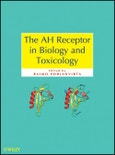Table of Contents
Preface.A. Historical background.
1. History of Research on the AHR (Thomas A. Gasiewocz and Ellen C. Henry).
B. AHR as a ligand-activated transcription factor.
2. Overview of AHR functional domains and the classical signaling pathway: induction of drug-metabolizing enzymes (Qiang Ma).
3. Role of chaperone proteins in AHR function (Iain A. Murray and Gary H. Perdew).
4. AHR Ligands: Promiscuity in Binding and Diversity in Response (Danica DeGroot, Guochun He, Domenico Fraccalvieri, Laura Bonati, Allesandro Pandin and Michael S. Denison).
5. Dioxin response elements and regulation of gene transcription (Hollie Swanson).
6. The AHR/ARNT dimer and transcriptional coactivators (Oliver Hankinson).
7. Regulation of AHR by the AHR repressor (AHRR) (Yoshiaki Fujii-Kuriyama and Kaname Kawajiri).
8. Influence of HIF-1α and Nrf2 signaling on AHR-mediated gene expression, toxicity and biological functions (Thomas Haarmann-Stemmann and Josef Abel).
9. Functional interactions of AHR with other receptors (Sara Brunnberg, Elin Swedenborg and Jan-Åke Gustafsson).
10. The E3 ubiquitin ligase activity of transcription factor AHR permits non-genomic regulation of biological pathways (Fumiaki Ohtake and Shigeaki Kato).
11. Epigenetic mechanisms in AHR function (Chia-I Ko and Alvaro Puga).
C. AHR as a mediator of xenobiotic toxicities: dioxins as a key example.
12. Role of the AHR and its structure in TCDD toxicity (Raimo Pohjanvirta, Merja Korkalainen, Ivy D. Moffat, Paul C. Boutros, Allan B. Okey).
13. Nongenomic route of action of TCDD: Identity, characteristics and toxicological significance (Fumio Matsumura).
14. Inter-species heterogeneity in the hepatic transcriptomic response to AHR activation by dioxin (Paul Boutros).
15. Dioxin-activated AHR: toxic responses and the induction of oxidative stress (Sidney J. Stohs and Ezdihar A. Hassoun).
16. Dioxin-activated AHR and cancer in laboratory animals (Dieter Schrenk and Martin Chopra).
17. Teratogenic impact of dioxin-activated AHR in laboratory animals (Barbara D. Abbott).
18. The developmental toxicity of dioxin to the developing male reproductive system in the rat; relevance of the AHR for risk assessment (David R. Bell).
19. TCDD, AHR and immune regulation (Nancy I. Kerkvliet).
20. Effects of dioxins on teeth and bone: the role of AHR (Matti Viluksela, Hanna M. Miettinen and Merja Korkalainen).
21. Impacts of dioxin-activated AHR signaling in fish and birds (Michael T. Simonich and Robert L. Tangray).
22. Adverse Health Outcomes Caused By Dioxin-Activated AHR in Humans (Sally S. White, Suzanne E. Fenton, and Linda S. Birnbaum).
23. The toxic equivalency principle and its application in dioxin risk assessment (Jouko Tuomisto).
24. AHR-active compounds in the human diet (Stephen Safe, Gayathri Chadalapaka and Indira Jutooru).
25. Modulation of AHR function by heavy metals and disease states (Anwar Anwar-Mohammed and Ayman O.S. El-Kadi).
26. Transgenic mice with a constitutively active AHR: a model for human exposure to dioxin an other AHR ligands (Patrik Andersson, Sara Brunnberg, Carolina Wejheden, Lorenz Poellinger and Annika Hanberg).
D. AHR as a physiological regulator.
27. Structural and functional diversification of AHRs during metazoan evolution (Mark E. Hahn and Sibel I. Karchner).
28. Invertebrate AHR homologs: Ancestral functions in sensory systems (Jo Anne Powell-Coffman and Hongtao Qin).
29. Role of AHR in the development of the liver and blood vessels (Sahoko Ichihara).
30. Involvement of the AHR in cardiac function and regulation of blood pressure (Jason A. Scott and Mary K. Walker).
31. Involvement of the AHR in development and functioning of the female and male reproductive systems (Bethany N. Karman, Isabel Hernández-Ochoa, Ayelet Ziv-Gal, Jodi A. Flaws).
32. The AHR in the control of cell cycle and apoptosis (Cornelia Dietrich).
33. The AHR regulates cell adhesion and migration by interacting with oncogene and growth factor-dependent signaling (Angel Carlos Roman, Jose M. Carvajal-Gonzalez, Sonia Mulero-Navarro, Aurea Gomez-Duran, Eva M. Rico-Leo and Pedro M. Fernandez-Salguero).
34. The physiological role of AHR in the mouse immune system (Charlotte Esser).
35. AHR and the circadian clock (Shelley A. Tischkau).
Samples

LOADING...








